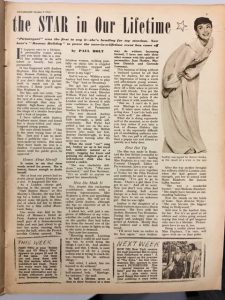Picturegoer magazine was a British magazine which ran between 1911 and 1960. It featured all the latest news surrounding the current films and the celebrity culture surrounding their stars. Looking at editions throughout the decades is a great example of not only early cinema fan culture but can also be an interesting reflection on social issues of the time. Most notably – female media representation. Raunchily dressed woman posing in sexually provocative positions can be found on countless covers, with such stars such as Bette Davis and Paulette Goddard contributing to the practice. In a side to side comparison to modern film and celebrity articles, it could be argued that little has changed within the manner of the sexual exploitation of woman within the industry in the pursuit of commercial affluency.
“The star is at once ordinary and extraordinary, available for desire and unattainable.” In his article ‘Stars as a Cinematic Phenomenon’ John Ellis talks about the paradox of stardom, how a star can be two things at once. In Paul Holt’s article in ‘Picturegoer,’ Audrey Hepburn is very much described as the young and innocent ‘girl next door’ who most people could identify with. “When the word “cut” rang out, Audrey sat up in her royal bed, suddenly natural as a puppy, hugging her knees and grinning the delighted grin of a well-behaved child who has earned a cookie.” (Holt) It would have been a very different description had the actress in question been Marilyn Monroe for example, who was undoubtedly conveyed as a goddess more than a human. However, this article has been teamed with a stunning headshot of Audrey, who looks more than just an ‘everywoman’ thus exemplifying the paradox Ellis suggests, that stars must be both “ordinary and extraordinary.”
The title of the article expresses positivity and excitement, capitalising the word ‘star’ to emphasise stardom and attract audiences interested in the celebrity aspect of cinema. The article praises Hepburn’s performance and her overall as a person, giving readers an insight into the behind the scenes filming of the movie. Articles like this would attempt to create relations between readers and audiences to create an intimacy between them and the actors, encouraging them to watch the film. Creating a familiarity and admiration towards the stars of the film was (and is still today) a successful marketing technique. Films began to use fame as a prime selling point; rather than a focusing on the story itself, audiences would be drawn in by the actors involved. This article by Holt does exactly that, focusing the page on the ‘new’ actress in the business, foreshadowing Hepburn’s rocketing career.

GOOD PRACTICE FEEDBACK
This is a thoughtful post showing some good clear thinking that unites your two modules at this point, considering how what you’ve learned about stardom and star theory on Film Analysis can inform your reading of historical primary sources on Film History. You select a productive extract from the article on Hepburn to illustrate how the magazine emphasizes her relatability alongside her ‘extraordinary’ star qualities, and the contrast with Monroe is particularly interesting. The recurrent comparison between past and present approaches to stardom opens up some interesting questions about what has / hasn’t changed in the ways stars are produced by varied media texts and consumed by audiences.